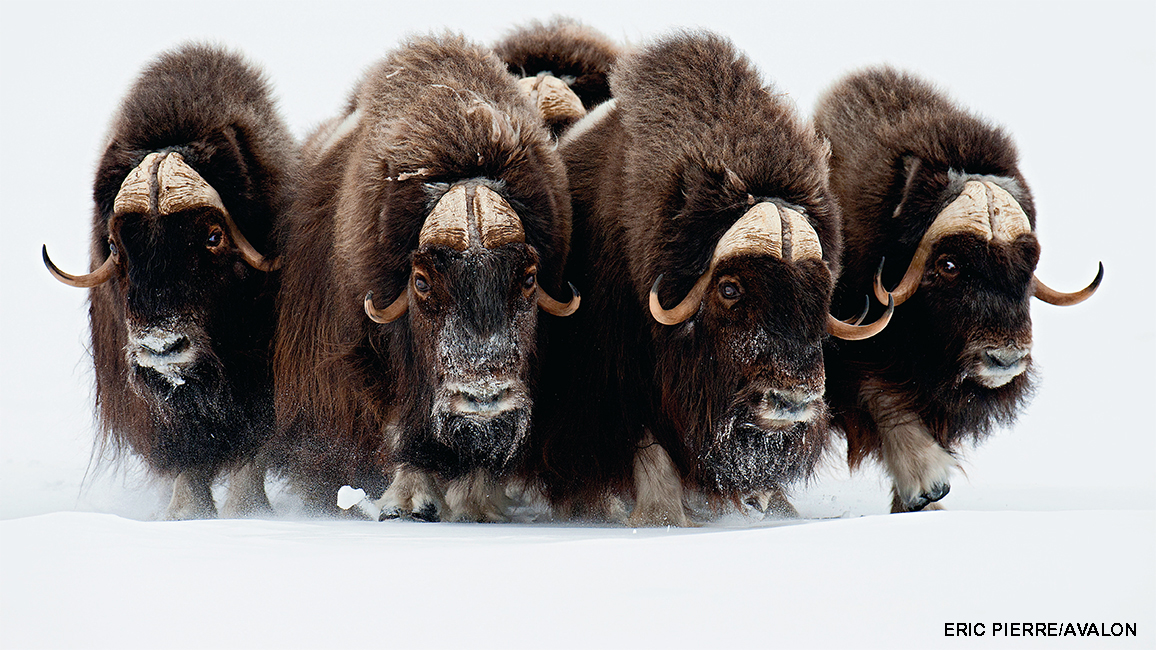
Winter Warriors: Muskoxen
By Anne CisselWind, ice, and snow? Just another day for muskoxen.
This group looks tough doesn’t it? It’s a herd of muskoxen—coming your way! Even though they eat only plants, you wouldn’t want to get too close. Just look at those sharp horns. Both males and females have them. Also, each muskox can weigh up to 1,000 pounds and run fairly fast. Best to stay out of their way.
WATCH MUSKOXEN IN ACTION!
Don’t be fooled by the name “muskoxen.” These mammals are more closely related to goats and sheep than to the oxen you might see pulling a cart in an old picture. But they really are very different from all those animals. Take their “neighborhood,” for example. They live in the Arctic, at the top of the world. There, snow can stay on the ground for 10 months of the year, and dip way below zero. It’s not easy to survive there. But muskoxen are used to such harsh conditions.
During the last glacial period, which some people call the Ice Age and which ended about 11,500 years ago, muskoxen lived alongside woolly mammoths and saber-toothed cats. Those animals began going extinct as the Ice Age ended, but not muskoxen. They are survivors. Let’s bundle up and follow the herd!
STAYING WARM AND FED
Many arctic animals migrate to warmer areas or stay snug in dens during the winter. But muskoxen remain active in the Arctic year-round, using a few different tricks to survive.
 Muskoxen might win the prize for the shaggiest animals on Earth. They have topcoats of long, brown guard hairs that keep growing throughout their lives! Those coats provide a lot of warmth and protection. But their soft undercoats are even warmer. This woolen layer, called qiviut (KIV-ee-ut), grows thick in the winter and sheds out in summer. During winter, a herd usually has about 25 or so muskoxen in it. They often huddle for warmth. To find enough food during those cold months, muskoxen use their front hooves to crack through the snow and ice to uncover grasses, mosses, and other hidden treats. Even so, food is scarce in the winter. Muskoxen save energy by moving very little and slowing their breathing and heart rates. If they don’t use a lot of energy, they don’t need to eat as much.
Muskoxen might win the prize for the shaggiest animals on Earth. They have topcoats of long, brown guard hairs that keep growing throughout their lives! Those coats provide a lot of warmth and protection. But their soft undercoats are even warmer. This woolen layer, called qiviut (KIV-ee-ut), grows thick in the winter and sheds out in summer. During winter, a herd usually has about 25 or so muskoxen in it. They often huddle for warmth. To find enough food during those cold months, muskoxen use their front hooves to crack through the snow and ice to uncover grasses, mosses, and other hidden treats. Even so, food is scarce in the winter. Muskoxen save energy by moving very little and slowing their breathing and heart rates. If they don’t use a lot of energy, they don’t need to eat as much.
READY FOR SPRING
Though the herd is a tight-knit group in the winter, the males, or bulls, will fight each other to find out who is the boss. When mating season comes in the summer and fall, only the top bulls get to mate.
When the temperature warms, muskoxen shed their qiviut. The soft hairs get caught on bushes and shrubs. The muskoxen may be done with it, but qiviut is valuable to others. For example, birds and other animals use it to line their nests and dens. And people collect it to make clothing, because it is soft and warm but lightweight.
SPRING BABIES
In spring, grasses and leaves grow back, giving muskoxen plenty to eat. They need energy after that long winter without much food. This is also the time when the female muskoxen, or cows, get ready to give birth.
Each cow usually has only one calf at a time. The calves can walk within a few hours of birth and are soon able to keep up with the herd. But they still need protection. Arctic wolves, brown bears, polar bears, and other predators could take down a calf that wandered away from its herd. When the herd senses danger, the members use teamwork to protect the young. They circle around the calves, with the bigger bulls on the outer edges of the circle. Standing shoulder to shoulder, with their huge heads down and horns plainly visible, the muskoxen challenge the enemy. Most predators will walk away from such a strong defense.
During pregnancy and nursing, the cows are the leaders of the herd. They decide when the herd moves on to a new grazing area and where to sleep at night. But then things change.
THE RUT
In the late summer, it’s mating season, known as the rut. During the rut, the bulls are in charge. They give off a strong musk, or odor, which attracts females. (That’s how muskoxen got their name!) They also roar. It really does sound like a tiger’s roar! To decide who gets to mate and who doesn’t, the bulls have dramatic fights. Two challengers stand far apart and then charge at each other, bashing their heads together. They can do this as many as 20 times in a row! Luckily, the base of a muskox’s horns forms a kind of helmet. The skull is thick, too. Whichever muskox gives up first loses the right to mate. The loser will leave the herd in search of another group of cows to mate with. Soon, winter comes again. When the wind, ice, and snow return, the muskoxen are ready to face it together!






















